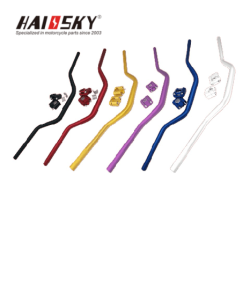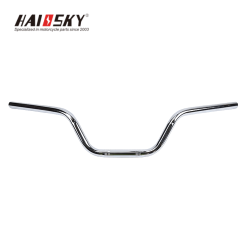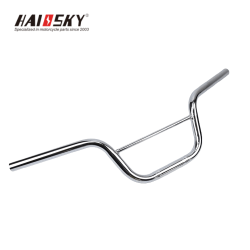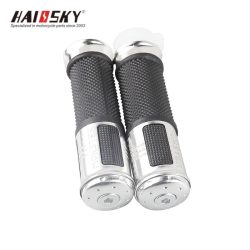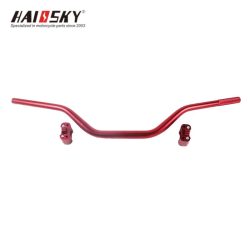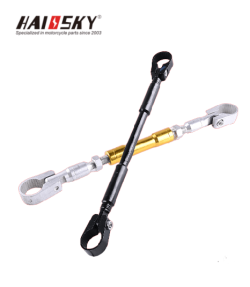OEM Motorcycle Parts
Category: Motorcycle Handlebars - Riser & Clip-On Styles
Everything You Need to Know About Motorcycle Handlebars
The motorcycle handlebar is one of the most critical components of a bike, serving as the primary interface between the rider and the motorcycle. It allows riders to steer, control, and balance their bikes while providing a comfortable grip for long rides. At Haissky.com, we specialize in providing high-quality motorcycle handlebars to B2B wholesalers and riders. In this guide, we’ll explore the types of handlebars, their specifications, maintenance tips, and how to choose the right handlebars for your motorcycle. We’ll also answer some frequently asked questions to help you make informed decisions.
What Are Motorcycle Handlebars?
Motorcycle handlebars are the steering control mechanism mounted on the front of the bike, connected to the front fork and wheel. They come in various shapes, sizes, and materials, each designed to suit different riding styles, comfort levels, and performance needs. Handlebars are not just functional; they also play a significant role in the overall aesthetics of the motorcycle.
Types of Motorcycle Handlebars
Motorcycle handlebars come in a variety of designs, each tailored to specific riding styles and preferences. Here are the most common types:
1. Riser Handlebars
Riser handlebars are characterized by their upward and backward curve, providing a more upright and comfortable riding position.
Pros: Ideal for long-distance touring and cruising, reduces strain on the back and arms.
Cons: May not be suitable for aggressive or sporty riding.
2. Clip-On Handlebars
Clip-on handlebars are mounted directly to the fork tubes and are commonly found on sportbikes. They offer a forward-leaning riding position for better aerodynamics and control at high speeds.
Pros: Enhances performance and control for sport and track riding.
Cons: Less comfortable for long rides or casual cruising.
3. Cruiser Handlebars
Cruiser handlebars are wide and high, designed for a relaxed and laid-back riding style. They are perfect for leisurely rides on city streets or open highways.
Pros: Promotes a comfortable, upright riding position.
Cons: Limited maneuverability for tight turns or aggressive riding.
4. Adventure Bike Handlebars
Adventure bike handlebars are designed for versatility, offering comfort and control both on and off-road. They are typically wider and higher, with integrated controls for functions like cruise control and heated grips.
Pros: Ideal for long-distance touring and off-road adventures.
Cons: May feel bulky for riders who prefer a sportier setup.
5. Ape Hangers
Ape hangers are tall handlebars that extend above the rider’s shoulders, often seen on custom or chopper-style motorcycles.
Pros: Unique aesthetic and relaxed arm position.
Cons: Can be uncomfortable for long rides and may reduce control.
6. Drag Bars
Drag bars are low and straight, designed for a forward-leaning riding position. They are commonly used on drag racing bikes or café racers.
Pros: Improves aerodynamics and control at high speeds.
Cons: Less comfortable for casual or long-distance riding.
Specifications and Maintenance of Motorcycle Handlebars
Proper maintenance ensures the longevity and performance of your motorcycle handlebars. Here are some key specifications and tips:
1. Material
Handlebars are typically made from steel, aluminum, or carbon fiber. Steel is durable and affordable, aluminum is lightweight and corrosion-resistant, and carbon fiber is lightweight and strong but expensive.
2. Diameter
The standard diameter for most handlebars is 1 inch (25.4 mm) at the clamp area and 7/8 inch (22.2 mm) at the grip area.
3. Width
Handlebar width affects control and comfort. Wider handlebars provide better stability, while narrower ones offer agility.
4. Height
Handlebar height influences the rider’s posture. Higher handlebars promote an upright position, while lower ones are better for aerodynamics.
5. Pullback and Bend
Pullback refers to how far the handlebars curve back toward the rider, while bend refers to the angle of the grips. Both affect comfort and control.
6. Maintenance Tips:
Regular Cleaning: Clean the handlebars with a mild detergent and soft cloth to remove dirt and grime.
Inspect for Damage: Check for cracks, bends, or wear and tear. Replace damaged handlebars immediately.
Lubricate Controls: Lubricate the throttle, brake, and clutch mechanisms to ensure smooth operation.
Tighten Bolts: Regularly check and tighten the bolts securing the handlebars to prevent loosening.
How to Choose the Right Motorcycle Handlebars
Selecting the right handlebars depends on your motorcycle’s make, model, and your specific riding needs. Here are some factors to consider:
1. Riding Style
Choose handlebars that match your riding style—riser bars for touring, clip-ons for sport riding, or cruiser bars for relaxed cruising.
2. Comfort
Consider the height, width, and pullback of the handlebars to ensure a comfortable riding position.
3. Material
Opt for durable materials like aluminum or steel for long-lasting performance.
4. Compatibility
Ensure the handlebars are compatible with your motorcycle’s controls and mounting system.
5. Budget
Set a budget and choose handlebars that offer the best value for money without compromising on quality.
How to Replace Motorcycle Handlebars
Replacing motorcycle handlebars is a straightforward DIY task if you have the right tools and knowledge. Here’s a step-by-step guide:
Tools Needed:
Screwdrivers
Allen wrench or socket wrench
Torque wrench
New handlebars
Steps:
Prepare the Motorcycle: Park the bike on a level surface and disconnect the battery.
Remove the Old Handlebars: Loosen the bolts securing the handlebars and disconnect any controls or cables.
Install the New Handlebars: Position the new handlebars and reconnect the controls and cables.
Secure the Handlebars: Tighten the bolts using a torque wrench to ensure proper installation.
Reconnect the Battery: Reconnect the battery and test the new handlebars for proper function.
Frequently Asked Questions
Q1: How do I know what handlebars to get for my motorcycle?
Consider your riding style, comfort preferences, and compatibility with your motorcycle’s controls and mounting system.
Q2: Why do bikers have their handlebars so high?
High handlebars, like ape hangers, provide a relaxed arm position and a unique aesthetic, but they may reduce control and comfort for long rides.
Q3: What is the most comfortable motorcycle handlebar position?
The most comfortable position depends on your riding style. Riser bars and cruiser bars are generally more comfortable for upright riding, while clip-ons are better for sporty riding.
Q4: Why do bikers hang ropes on their handlebars?
Ropes on handlebars are often used as a decorative element or as a makeshift tool for securing cargo.
Conclusion
Motorcycle handlebars are a vital component that affects control, comfort, and aesthetics. Whether you’re a B2B wholesaler or a rider, understanding the types, maintenance, and selection of handlebars is crucial for optimal performance and safety.
At Haissky.com, we offer a wide range of high-quality motorcycle handlebars designed to meet the needs of every rider. Explore our collection today and find the perfect handlebars for your inventory or personal use!



